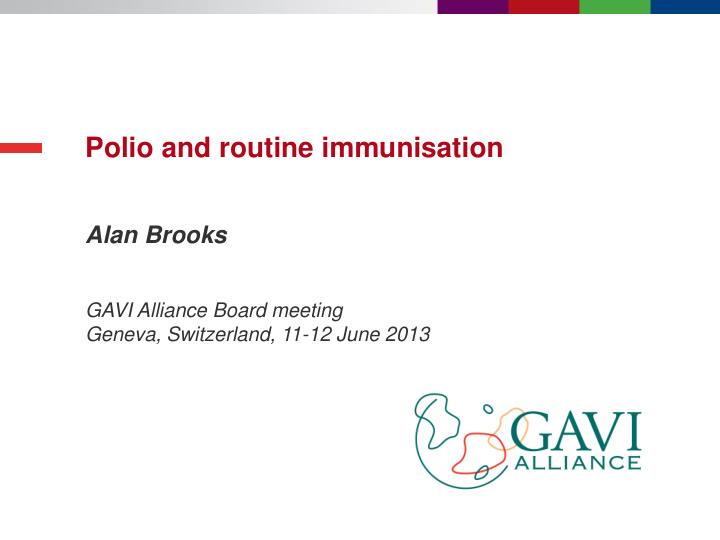



Polio and routine immunisation Alan Brooks GAVI Alliance Board meeting Geneva, Switzerland, 11-12 June 2013
Background GAVI Alliance Board meeting 11-12 June 2013 1
History of polio eradication World Health Assembly Resolution Previous eradication targets 400 Polio cases (thousands) Last case 300 of wild type 2 virus Africa initiates 200 Campaigns India’s last case of wild 100 Eliminated from virus Americas 0 1985 1986 1987 1988 1989 1990 1991 1992 1993 1994 1995 1996 1997 1998 1999 2000 2001 2002 2003 2004 2005 2006 2007 2008 2009 2010 2011 2012 GAVI Alliance Board meeting 11-12 June 2013 2
Polio Eradication and Endgame Strategic Plan (2013-2018) Oral polio vaccines (OPV) causing a growing percentage of cases Inactivated polio vaccine (IPV) in routine immunisation could Prevent polio cases caused by oral polio vaccine Help mitigate against risk of outbreaks Last wild Begin phasing Global Stop Last wild Last OPV2 Global bOPV certification polio case out OPV OPV polio case use Certification cessation 2013 2014 2015 2016 2017 2018 2019 Strengthen routine immunisation Objective 2: Routine Begin phasing Complete immunisation, IPV in routine immunisation in IPV IPV IPV, & OPV phasing out Prepare to phase out OPV Phasing out OPV GAVI Alliance Board meeting 11-12 June 2013 3
GAVI’s complementary role to the Global Polio Eradication Initiative (GPEI) in the eradication effort Inactivated polio vaccine implementation Share lessons from over 130 routine programme new vaccine introductions over 13 years Immunisation strategies & support to countries Advocacy and communications with consistent messages Potential for resource mobilisation through innovative financing instruments Ongoing investments through Business Plan GAVI Alliance Board meeting 11-12 June 2013 4
IPV: GAVI Alliance’s comparative advantage supporting introduction into routine immunisation Proven approach, track record in implementation and established lines of communication GAVI estimates 50-60 introductions (e.g. pneumo) per year through 2015 Country-driven policies and processes Existing investments through the business plan Opportunity to coordinate vaccine introductions (and mitigate risk toGAVI programmes) GAVI Alliance Board meeting 11-12 June 2013 5
Costs Estimated IPV costs (1 dose) (US$ Millions) Introduction timing (2014) 2015 2016-2020 2015-2024 52 countries in 2015 90 245 490 (GPEI official scenario) 10 priority countries in 35 250 440 2015; 42 in 2016 Includes vaccine procurement, syringes, safety boxes and freight Vaccine introduction grants: Additional approximately US$40 million Does not include India GAVI Alliance Board meeting 11-12 June 2013 6
Potential GAVI programme and policy implications Issues for GAVI, GPEI, WHO and others to work on prior to November Board, include: Analyses or new data Coordinated IPV plan, including demand forecast Contingency plan around Endgame timeline Coverage targets to achieve purpose Policy or processes Coverage requirement (eligibility) to apply for IPV Application, review, approval, and monitoring Co-financing (and default) GAVI Alliance Board meeting 11-12 June 2013 7
PPC Recommendation Request the Secretariat – recognising the urgency of timing in the polio eradication effort and that considerations for Inactivated Polio Vaccine (IPV) are not consistent with the VIS criteria or timing – to prepare for procurement and implementation of GAVI support for the introduction of IPV in the routine immunisation programmes of GAVI countries as recommended by WHO as a contribution to polio eradication. These preparations and implementation shall take into account forthcoming recommendations from SAGE and be in consultation with Alliance partners. Approval will be subject to sufficient additional funding being available and Board endorsement of moving this forward outside the timing of the VIS process and the Board will note that there may need to be changes to GAVI policies which would need to be approved by the Board or the Executive Committee. GAVI Alliance Board meeting 11-12 June 2013 8
Additional considerations for implementing the PPC recommendation Availability of additional funding Implementation: Based on country-driven decisions to introduce IPV, that are part of national planning processes Carried out using GAVI’s structures, policies and processes in so far as this is possible, recognizing that some exceptions may need to made Mitigating potential risk to achieving GAVI’s business plan targets GAVI Alliance Board meeting 11-12 June 2013 9
GAVI Alliance Board meeting 11-12 June 2013 10
Recommend
More recommend